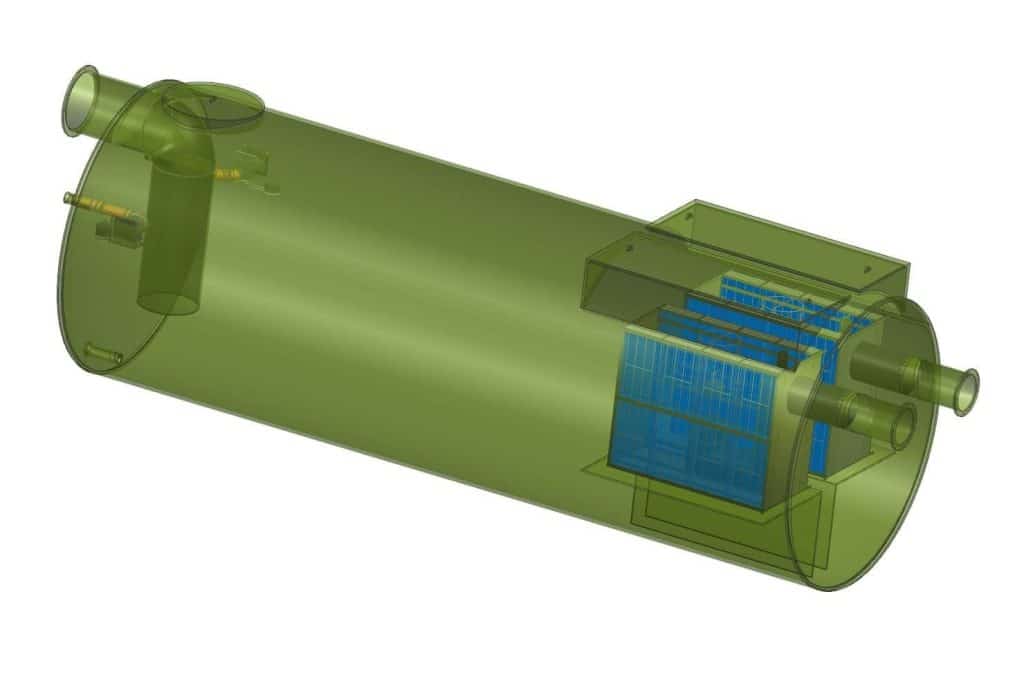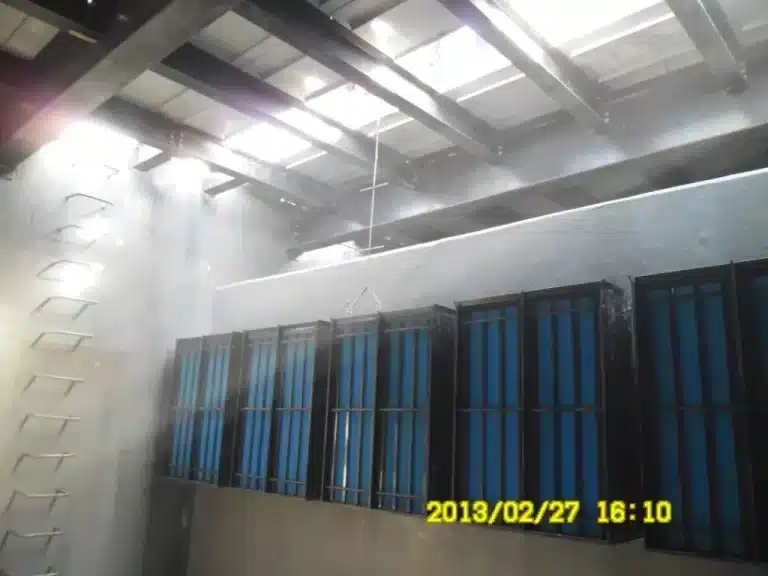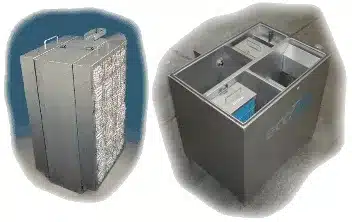Ever wondered how California keeps its waterways clean despite bustling industries? The answer lies beneath our feet. California Below Ground Oil Water Separators are key to keeping the state’s environment safe. These systems are the hidden champions of stormwater management and following environmental laws.
From big industrial sites to small car washes, many places in California use these systems. They work hard to keep oil and water apart before they reach our sewers and rivers. These separators can handle a lot, from 50 to 5,000 gallons of water per minute, making them flexible for different needs.
California is a leader in protecting the environment, and knowing about these systems is important. They’re not just about following rules; they’re about keeping our natural resources safe for the future.
Key Takeaways
- Freytech Inc. Below ground oil water separators are essential for California’s environmental compliance
- These systems handle wastewater with oil or sediment from various facilities
- Capacities range from 50 to 5,000 gallons per minute to suit different needs
- They play a vital role in stormwater management and pollution prevention
- Understanding these systems is crucial for businesses operating in California
Understanding Below Ground Oil Water Separators in California
California is serious about protecting the environment. It has strict rules for managing industrial wastewater. Below ground oil water separators are key in following these rules. They are vital for places that produce oily wastewater, keeping our water safe and following state laws.
Definition and Purpose of Oil Water Separators
Oil water separators remove oils and greases from wastewater. They use the difference in density between oil and water to work. These systems are great at taking out substances with a specific gravity between 0.7 and 0.94 from water.
Importance in California’s Environmental Regulations
California makes many businesses install oil water separators. These rules stop oil and grease from getting into storm drains and rivers. By treating wastewater, these systems help businesses meet discharge limits and avoid big fines.
Types of Facilities Requiring Oil Water Separators
Many facilities need oil water separators in California. This includes quick-lube stations, vehicle repair shops, and places where fuel is sold. Even businesses using steam or pressure washers need them. The aim is to make sure all industrial wastewater is treated right before it’s released.
Design and Construction of Below Ground Oil Water Separators
Below ground oil water separators are key in treating wastewater. They are made to follow strict environmental rules and handle spills well.
Materials and Fabrication Standards
Carbon steel is the main material for making these separators. They are built to last, meeting UL-58 and UL-1746 standards. The making process is strict to ensure they work well underground.
UL Listings and Compliance Requirements
UL-2215 testing checks if these separators work as they should. This makes sure they’re safe and perform well. Meeting these standards is a must for places that treat wastewater and contain spills.
Single vs. Double Wall Configurations
Oil water separators have single and double walls. Double walls have extra protection and can spot leaks early. This adds an extra safety layer for places that need it. Both types can be coated to fight corrosion and last longer.
California Below Ground Oil Water Separators: Key Features
Below ground oil water separators in California have advanced features for efficient oil-water separation. They are key in preventing stormwater pollution and treating industrial wastewater.
Non-clogging flow distributors make sure the system runs smoothly. Energy dissipater devices help reduce turbulence. Stationary underflow baffles and presettling chambers catch solids before they reach the main area. This setup boosts the separator’s effectiveness.
The main part of these systems is their oil coalescing chambers. They use removable parallel corrugated plate coalescers and sectionalized polypropylene impingement coalescers. These technologies help separate free oil from water, making oil removal more efficient.
California’s separators work at atmospheric pressure. They need proper venting for inlets, outlets, and manways to work well. These features help them meet California’s high environmental standards and offer reliable stormwater management.
Operational Principles of Below Ground Separators
Below ground oil water separators are vital for managing stormwater and following environmental laws. They use advanced methods to separate oil and water efficiently.
Stokes Law and Separation Efficiency
Stokes Law is the main idea behind separating oil from water. It shows how oil droplets move up in water. Engineers use this to design better separators that remove more oil from water.
Coalescing Technology for Enhanced Performance
Modern separators use coalescing technology to work better. This technology makes small oil droplets merge into bigger ones. This makes it easier to remove them. Thanks to this, separators can now remove oil down to 5 parts per million.
Flow Rate Capacity and Sizing Considerations
Choosing the right size is crucial for a separator to work well. They can handle flows from 50 to 5,000 gallons per minute. New designs can even separate more than older units of the same size.
When picking a size, think about the flow rate and oil levels. This ensures the separator works best in different industrial settings.
Installation and Maintenance of Underground Oil Separators
Putting in below ground oil water separators right is key for good wastewater treatment. You need to pay close attention to venting and follow the maker’s rules. This makes sure they work well and meet environmental laws.
Keeping these systems in good shape is important. Experts say to check them every 180 days. Doing this early catches problems and keeps the wastewater treatment efficient.
Modern separators are made with safety first. They don’t need you to go into tight spaces for upkeep. This cuts down on the risks of maintenance work.
Adding electronic alarms can help with monitoring. These alarms sound and show alerts when the liquid in the separator gets too high. This tech helps with early maintenance and keeps places in line with environmental laws.
By sticking to these steps for putting in and looking after them, businesses make sure their underground oil separators keep helping with wastewater treatment and protecting the environment. Regular care not only makes the equipment last longer but also saves money on big compliance problems.
These separators are crucial in storm water systems. They process runoff to meet the US EPA’s Clean Water Act standards. With effective oily water treatment, facilities protect the environment and dodge big fines.
Environmental Benefits and Compliance
Below ground oil water separators are key for following California’s environmental laws. They keep our water clean and stop pollution in different industries.
Meeting California’s Stringent Standards
California demands a lot from the environment. Oil water separators help companies meet these tough rules. They take out oil and grease from water, making our waterways safe.
Stormwater Management and Pollution Prevention
Stopping stormwater pollution is very important in California. Oil water separators catch oil and pollutants before they go into storm drains. This keeps our water bodies safe from harmful runoff when it rains.
Industrial Wastewater Treatment
In industrial areas, oil water separators are vital for treating wastewater. They remove oil and grease from manufacturing process water. This water can then be safely released or reused, helping to protect our water resources.
But, these systems aren’t for all wastewater types. They’re best for oil and water mixes, not cleaning solvents or water with lots of dissolved solids.
Freytech Inc.’s Advanced Oil Water Separator Solutions
Freytech Inc. is at the forefront with top-notch oil water separator solutions. They use advanced coalescing technology for better separation. This makes them leaders in wastewater treatment.
Enhanced Coalescing Technology
Freytech’s enhanced coalescing technology is a game-changer. It’s great at separating different hydrocarbons like motor oil, diesel, gasoline, and jet fuel. This means cleaner water that meets North American standards.
Superior Separation Efficiency (5 PPM and Beyond)
Freytech’s oil water separators can separate to 5 PPM. This is way better than the North American limit of 10 PPM. For tiny amounts of emulsified oil, they can even get down to 0.1 PPM.
Customized Solutions for Various Industries
Freytech Inc. provides solutions that fit different industries. They offer customized separator packages for the best performance. This makes them a top choice for businesses needing reliable oil water separation.










